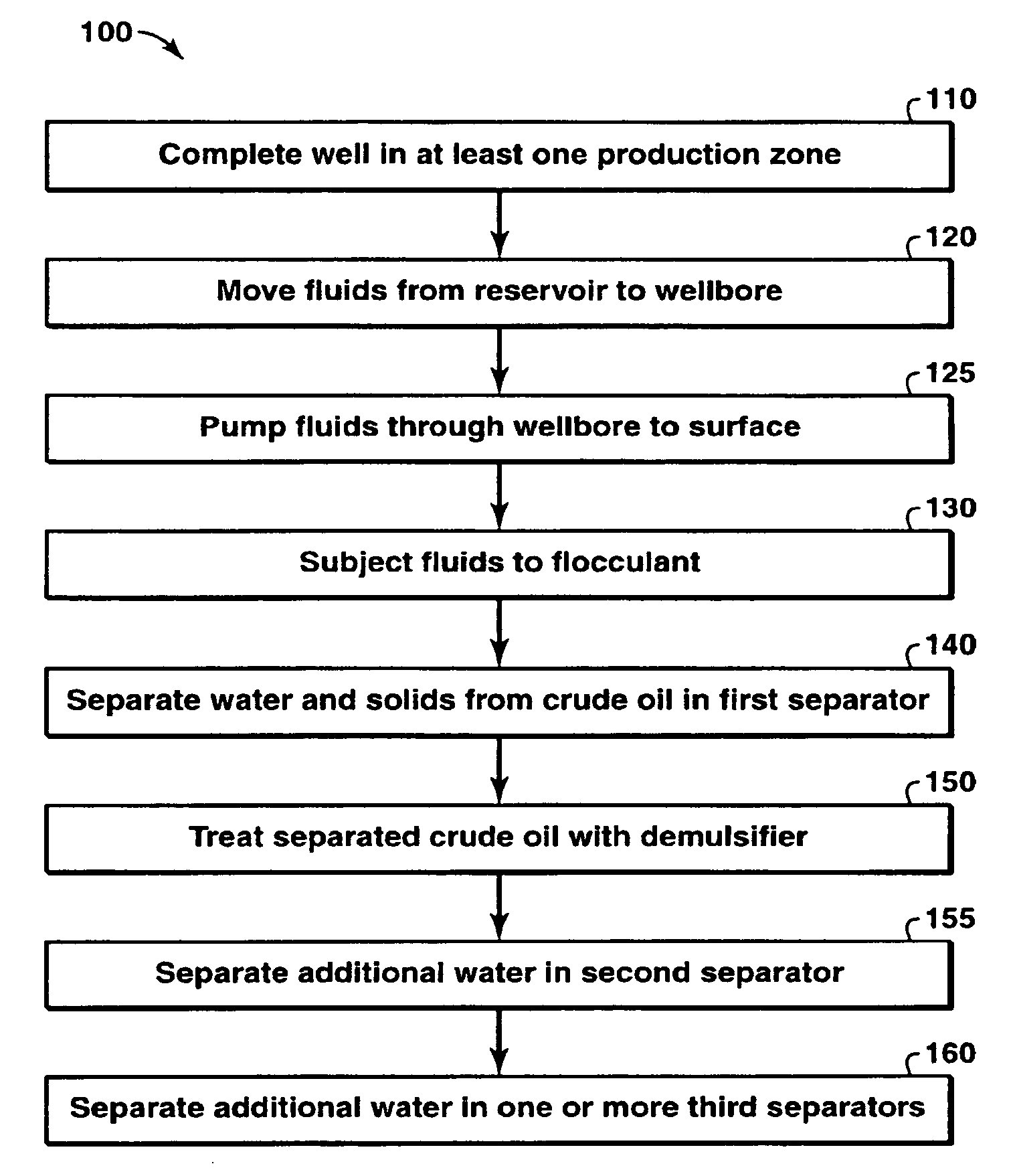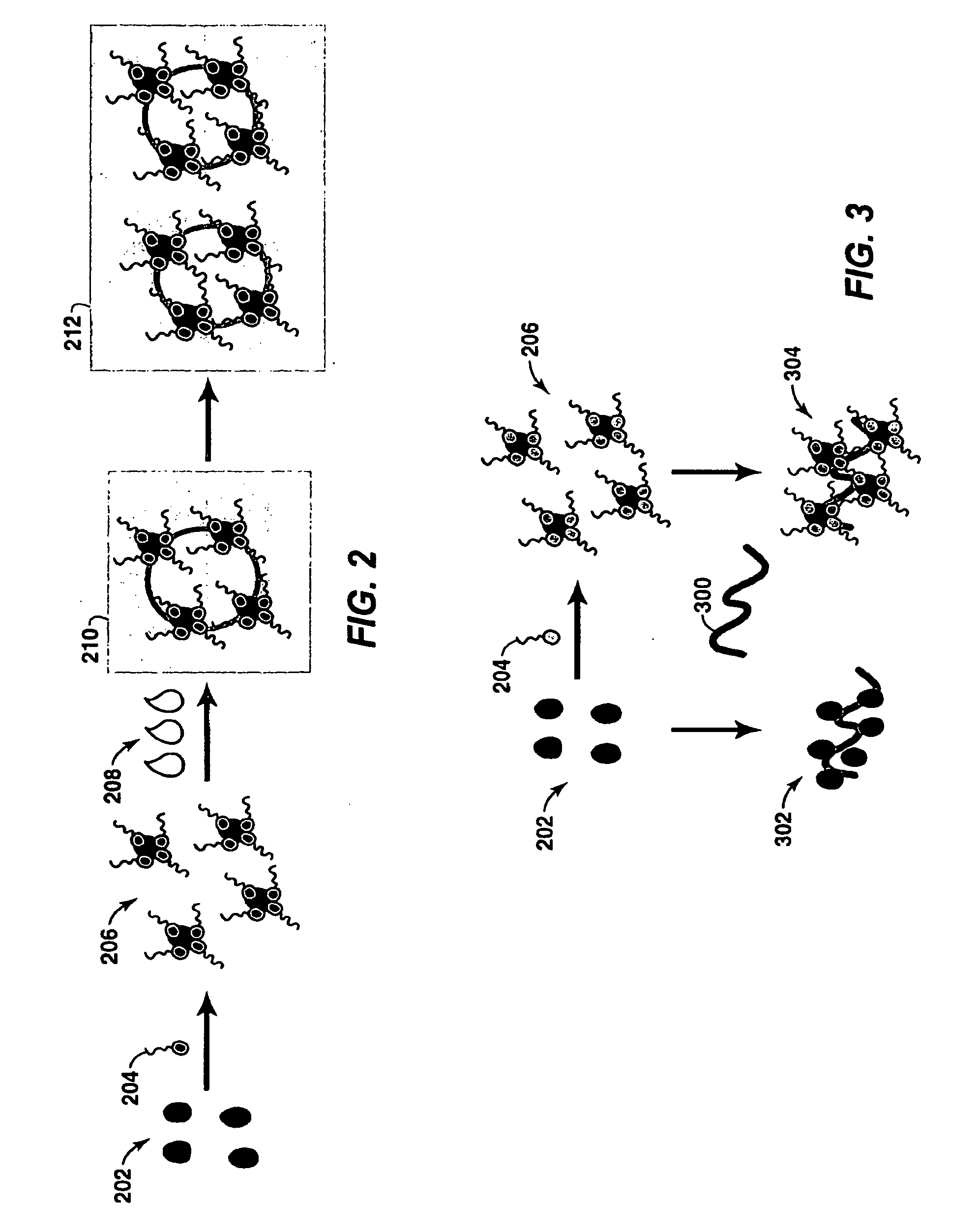Oil/Water Separation of Full Well Stream By Flocculation-Demulsification Process
a technology of demulsification process and oil/water, which is applied in the field of fluid separation, can solve the problems of limited effect of demulsifiers on heavy crude oil, asphaltenes, naphthenic acids and inorganic solids, and difficulty in separating water from crude oil, etc., and achieves the effect of improving the process for oil/water
- Summary
- Abstract
- Description
- Claims
- Application Information
AI Technical Summary
Benefits of technology
Problems solved by technology
Method used
Image
Examples
example 1
Demulsifier Only Treatment
[0082]An emulsion sample (referred to as Sample #1) was made by mixing in a Silverson mixer at 1,000 revolutions per minute (rpm):
[0083]75 grams of Gryphon crude oil,
[0084]6 milliliter (ml) of water,
[0085]0.03 grams BaSO4,
[0086]0.03 grams CaCO3, and
[0087]0.01 grams bentonite clay.
[0088]Thereafter, Pluronic®-F127 was added to the emulsion. Pluronic®-F127 is an ethoxylated propoxylated alcohol demulsifier manufactured by BASF Corporation. The demulsifier was mixed into the emulsion at 200 rpm and subjected to electrostatic demulsification. The treat rate for the demulsifier (0.0075 grams) was 0.01 wt. % of actives based on the weight of the emulsion. Electrostatic demulsification was then conducted at 70° C. and 830 volts / inch potential for 30 minutes using a laboratory electrostatic coalescer. The amount of water separated out of the Sample #1 emulsion was 8.3% by weight.
example 2
Flocculant Plus Demulsifier Treatment
[0089]An emulsion sample (referred to as Sample #2) was made by mixing in a Silverson mixer at 1,000 rpm:
[0090]75 grams (g) of Gryphon Crude oil,
[0091]6 ml of water,
[0092]0.03 grams BaSO4,
[0093]0.03 grams CaCO3,
[0094]0.01 g bentonite clay, and
[0095]Tramfloc-364 flocculant (cationic polyacrylamide).
[0096]The treat rate for the flocculant was (0.0075 grams) at 0.01 wt. % based on the weight of the emulsion. Thereafter, Pluronic®-F127 demulsifier was added to the emulsion and mixed at 200 rpm. The treat rate for the demulsifier (0.0075 grams) was 0.01 wt. % of actives based on the weight of the oil. The emulsion was also subjected to electrostatic demulsification. Electrostatic demulsification was conducted at 70° C. and 830 volts / inch potential for 30 minutes using a laboratory electrostatic coalescer. The amount of water separated out of the emulsion of Sample #2 was 83% by weight.
[0097]As can be seen, the amount of water separated from Sample #2 ...
example 3
Field Example from an Offshore Oil Field
[0098]Example 3 relates to emulsion problems encountered in the offshore operations. During 2005, emulsion problems appeared at a production facility in an offshore oil field. Two large parallel electrostatic coalescers in place at the production facility failed to separate water from produced crude oil. This resulted in curtailed production to a terminal.
[0099]External scanning of the coalescers was conducted to determine the internal state of the equipment. Scanning revealed that mud and sludge (“contaminated” sand) had deposited on the bottom of vessels and on electrodes. The coalescers were cleaned using high pressure flushing. As a result, 39 cubic meters (m3) of sludge and materials was removed from the vessels to place the coalescers back on line and in accordance with the exportation specifications (including less than 0.5% water). Further, additional jetting nozzles were installed in the coalescers and periodic jetting routines were e...
PUM
| Property | Measurement | Unit |
|---|---|---|
| operating temperature | aaaaa | aaaaa |
| operating temperature | aaaaa | aaaaa |
| operating temperature | aaaaa | aaaaa |
Abstract
Description
Claims
Application Information
 Login to View More
Login to View More - R&D
- Intellectual Property
- Life Sciences
- Materials
- Tech Scout
- Unparalleled Data Quality
- Higher Quality Content
- 60% Fewer Hallucinations
Browse by: Latest US Patents, China's latest patents, Technical Efficacy Thesaurus, Application Domain, Technology Topic, Popular Technical Reports.
© 2025 PatSnap. All rights reserved.Legal|Privacy policy|Modern Slavery Act Transparency Statement|Sitemap|About US| Contact US: help@patsnap.com



